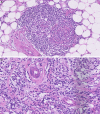Pitfalls in machine learning-based assessment of tumor-infiltrating lymphocytes in breast cancer: A report of the International Immuno-Oncology Biomarker Working Group on Breast Cancer
- PMID: 37608772
- PMCID: PMC10518802
- DOI: 10.1002/path.6155
Pitfalls in machine learning-based assessment of tumor-infiltrating lymphocytes in breast cancer: A report of the International Immuno-Oncology Biomarker Working Group on Breast Cancer
Abstract
The clinical significance of the tumor-immune interaction in breast cancer is now established, and tumor-infiltrating lymphocytes (TILs) have emerged as predictive and prognostic biomarkers for patients with triple-negative (estrogen receptor, progesterone receptor, and HER2-negative) breast cancer and HER2-positive breast cancer. How computational assessments of TILs might complement manual TIL assessment in trial and daily practices is currently debated. Recent efforts to use machine learning (ML) to automatically evaluate TILs have shown promising results. We review state-of-the-art approaches and identify pitfalls and challenges of automated TIL evaluation by studying the root cause of ML discordances in comparison to manual TIL quantification. We categorize our findings into four main topics: (1) technical slide issues, (2) ML and image analysis aspects, (3) data challenges, and (4) validation issues. The main reason for discordant assessments is the inclusion of false-positive areas or cells identified by performance on certain tissue patterns or design choices in the computational implementation. To aid the adoption of ML for TIL assessment, we provide an in-depth discussion of ML and image analysis, including validation issues that need to be considered before reliable computational reporting of TILs can be incorporated into the trial and routine clinical management of patients with triple-negative breast cancer. © 2023 The Authors. The Journal of Pathology published by John Wiley & Sons Ltd on behalf of The Pathological Society of Great Britain and Ireland.
Keywords: deep learning; digital pathology; guidelines; image analysis; machine learning; pitfalls; prognostic biomarker; triple-negative breast cancer; tumor-infiltrating lymphocytes.
© 2023 The Authors. The Journal of Pathology published by John Wiley & Sons Ltd on behalf of The Pathological Society of Great Britain and Ireland.
Figures


References
-
- Bates GJ, Fox SB, Han C, et al. Quantification of regulatory T cells enables the identification of high‐risk breast cancer patients and those at risk of late relapse. J Clin Oncol 2006; 24: 5373–5380. - PubMed
-
- Savas P, Salgado R, Denkert C, et al. Clinical relevance of host immunity in breast cancer: from TILs to the clinic. Nat Rev Clin Oncol 2016; 13: 228–241. - PubMed
-
- Hammerl D, Smid M, Timmermans AM, et al. Breast cancer genomics and immuno‐oncological markers to guide immune therapies. Semin Cancer Biol 2018; 52: 178–188. - PubMed
Publication types
MeSH terms
Substances
Grants and funding
- UH3 CA225021/CA/NCI NIH HHS/United States
- U24 CA224319/CA/NCI NIH HHS/United States
- UL1 TR001863/TR/NCATS NIH HHS/United States
- R01 CA268207/CA/NCI NIH HHS/United States
- P30 CA008748/CA/NCI NIH HHS/United States
- U01 CA239055/CA/NCI NIH HHS/United States
- R01 CA268287/CA/NCI NIH HHS/United States
- R01 CA220581/CA/NCI NIH HHS/United States
- U24 CA215109/CA/NCI NIH HHS/United States
- R01 CA216579/CA/NCI NIH HHS/United States
- R33 CA263705/CA/NCI NIH HHS/United States
- R01 CA202752/CA/NCI NIH HHS/United States
- R01 CA208236/CA/NCI NIH HHS/United States
- U01 DK124165/DK/NIDDK NIH HHS/United States
- R37 CA225655/CA/NCI NIH HHS/United States
- KCL-BCN-Q3/CRUK_/Cancer Research UK/United Kingdom
- U01 CA248226/CA/NCI NIH HHS/United States
- P50 CA116201/CA/NCI NIH HHS/United States
- P50 CA247749/CA/NCI NIH HHS/United States
- I01 BX004121/BX/BLRD VA/United States
- R43 EB028736/EB/NIBIB NIH HHS/United States
- C45982/A21808/CRUK_/Cancer Research UK/United Kingdom
- U01 CA269181/CA/NCI NIH HHS/United States
- CRUK/07/012/CRUK_/Cancer Research UK/United Kingdom
- R01 CA257612/CA/NCI NIH HHS/United States
- U54 CA254566/CA/NCI NIH HHS/United States
- P30 CA196521/CA/NCI NIH HHS/United States
- R01 CA249992/CA/NCI NIH HHS/United States
LinkOut - more resources
Full Text Sources
Research Materials
Miscellaneous

